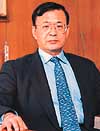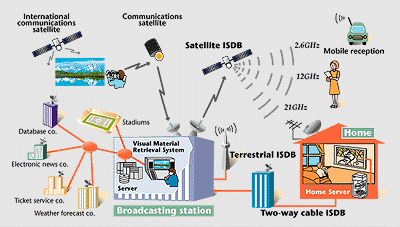Digitalization
of Broadcasting in Japan:
Based on ISDB developed by NHK
 By
Osamu YAMADA,
By
Osamu YAMADA,
Director-General, NHK Science & Technical Research Laboratories
This December, the long-anticipated digital satellite broadcasting (DSB)
services will finally begin. NHK and six commercial broadcasters will
broadcast digital HDTV programs as their main DSB services, with a further
several commercial broadcasters opting for digital sound, data and SDTV
services.
NHK and the commercial broadcasters are vigorously pursuing a goal of
10 million subscribing households within the first 1000 days of service.
A BS Digital Fair was held at the NHK Broadcasting Center in Tokyo from
April 29 through May 7, attracting over 200,000 visitors. With the cooperation
of commercial broadcasters, NHK was able to demonstrate to the public
both the superb visual quality of HDTV programs and the great benefits
of data broadcasting services.
In parallel, preparation continues for the scheduled start of digital
terrestrial broadcasting (DTB) in 2003. One of key issues for implementing
DTB is the Channel Plan given that almost all available frequencies are
already used to serve Japan's current analog broadcasts. The Joint Committee
Concerning DTB, comprising the Ministry of Posts and Telecommunications
(MPT), commercial broadcasters and NHK, reached a consensus this April
on the digital channels needed nationwide for master stations. The effort
will continue to reach a consensus on the large-scale relay stations by
the end of 2001.
There are three DTB systems currently in existence worldwide: DTV, developed
in the United States; DVB-T in Europe; and ISDB-T (Integrated Services
Digital Broadcasting for Terrestrial) in Japan. Many countries are now
considering adopting one of the three DTB systems and recent comparisons
conducted on "neutral" turf have favored ISDB-T.
In this issue of Broadcast Technology, we look back on the BS Digital
Fair and discuss some of the characteristics of digital terrestrial television
broadcasting and digital sound broadcasting.
 |
|
ISDB will offer various broadcasting services
expected to be available in the future, as shown in the diagram,
integrated and edited flexibly on a single channel, and sent to
households via various transmission media, including broadcasting
satellites, terrestrial broadcasting channels and optical fiber.
The laboratories are investigating various possible kinds of services,
signal transmission methods, and receivers. |
|
 |
|



